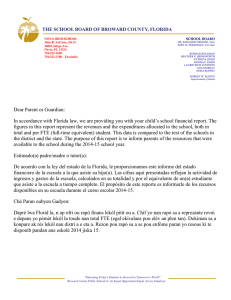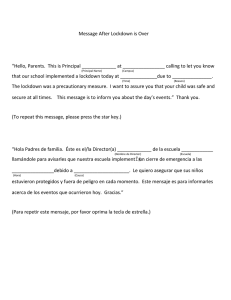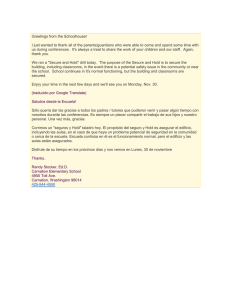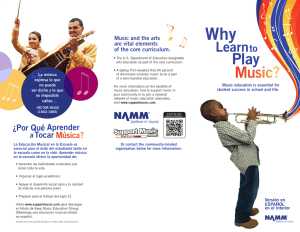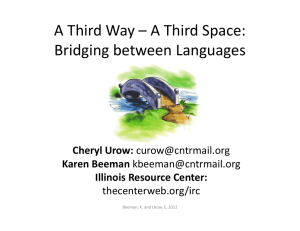WIDA and ELPA Can Do`s- How can I use these in a manageable
Anuncio
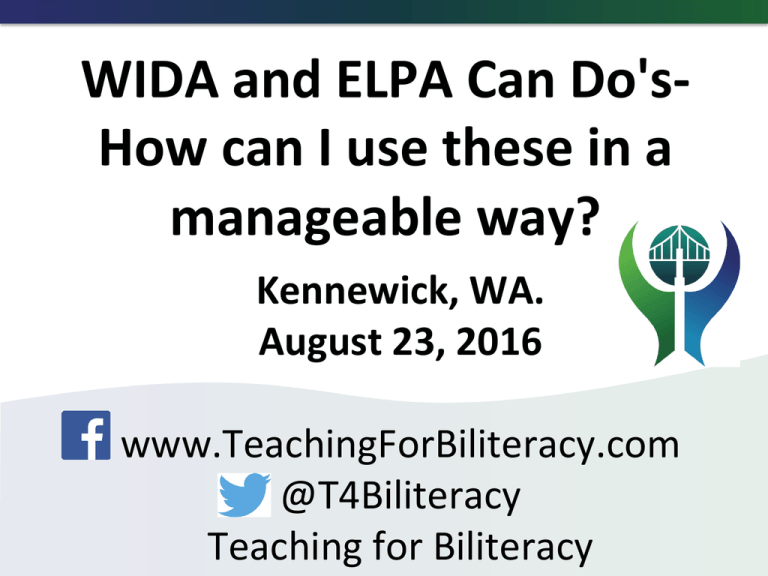
WIDAandELPACanDo'sHowcanIusetheseina manageableway? Kennewick,WA. August23,2016 www.TeachingForBiliteracy.com @T4Biliteracy TeachingforBiliteracy Agenda 1. LanguageProficiencyLevels:WhatThey Are 2. LanguageProficiencyLevels:Howto UseThem 3. QuesFonsandAnswers 4. Closure. www.TeachingForBiliteracy.com www.TeachingForBiliteracy.com LanguageProficiencyLevels: WhattheyAre StarPngwithYou! • AsIdothisSpanishlessonwithyou,think aboutwhatyourSpanishLanguageProficiency Levelis. • IdenFfythestrategiesthathelpyoulearn language(Spanish),literacy,andcontent. 4) 4GUQWTEG)WKFG (KIWTG/%#0&1&GUETKRVQTUHQTVJG.GXGNUQH'PINKUJ.CPIWCIG2TQſEKGPE[2TG- t Locate, select, order information from oral descriptions t Follow multi-step oral directions t Categorize or sequence oral information using pictures, objects t Compare/contrast functions, relationships from oral information t Analyze and apply oral information t Identify cause and effect from oral discourse t Draw conclusions from oral information t Construct models based on oral discourse t Make connections from oral discourse t Name objects, people, pictures t Answer WH- (who, what, when, where, which) questions t Ask WH- questions t Describe pictures, events, objects, people t Restate facts t Formulate hypotheses, make predictions t Describe processes, procedures t Retell stories or events t Discuss stories, issues, concepts t Give speeches, oral reports t Offer creative solutions to issues, problems t Engage in debates t Explain phenomena, give examples and justify responses t Express and defend points of view t Match icons and symbols to words, phrases or environmental print t Identify concepts about print and text features t Locate and classify information t Identify facts and explicit messages t Select language patterns associated with facts t Sequence pictures, events, processes t Identify main ideas t Use context clues to determine meaning of words t Interpret information or data t Find details that support main ideas t Identify word families, figures of speech t Conduct research to glean information from multiple sources t Draw conclusions from explicit and implicit text t Label objects, pictures, diagrams t Draw in response to a prompt t Produce icons, symbols, words, phrases to convey messages t Make lists t Produce drawings, phrases, short sentences, notes t Give information requested from oral or written directions t Produce bare-bones expository or narrative texts t Compare/contrast information t Describe events, people, processes, procedures t Summarize information from graphics or notes t Edit and revise writing t Create original ideas or detailed responses t Apply information to new contexts t React to multiple genres and discourses t Author multiple forms/ genres of writing .+56'0+0) .GXGN $TKFIKPI 52'#-+0) .GXGN Beginning t Point to stated pictures, words, phrases t Follow one-step oral directions t Match oral statements to objects, figures or illustrations t Sort pictures, objects according to oral instructions t Follow two-step oral directions t Match information from oral descriptions to objects, illustrations .GXGN &GXGNQRKPI .GXGN4GCEJKPI .GXGN 'ZRCPFKPI 94+6+0) .GXGN 'PVGTKPI WIDA/ELPA 4'#&+0) For the given level of English language proficiency, with support, English language learners can: 9DULDELOLW\RIVWXGHQWV¶FRJQLWLYHGHYHORSPHQWGXHWRDJHJUDGHOHYHOVSDQVWKHLUGLYHUVLW\RIHGXFDWLRQDOH[SHULHQFHVDQGGLDJQRVHGOHDUQLQJGLVDELOLWLHVLIDSSOLFDEOHDUHWREH considered in using this information. LasregionesdelosEstadosUnidos ElpaísdelosEstadosUnidosestácompuestode 5regionesque,aunquevaríanmuchoentreellas, compartenlasmismascaracterísFcas:topograXa, clima,historia,recursosnaturalesyhabitantes.La regióndelMedio-oesteFenerecursosnaturales vastos–árboles,agua,animalesyotrosrecursos importantes.Entresushabitantesoriginalesse encuentranindígenaseinmigrantesfrancesesy noruegos,mientrasqueloshabitantes contemporáneosincluyenlosdescendientesdelos habitantesanFguosjuntoconmuchosinmigrantes laFnosyAfro-Americanosquesetrasladaronal nortedelsurenlosaños50,50y70. LosEE.UU.Fenevariasregiones KarenBeeman,EscuelaFratney,August, 2014 Nosotrosvivimosenlaregióndel medio-oeste KarenBeeman,EscuelaFratney,August, 2014 CadaregiónFenecaracterísFcas únicas. LatopograXa Los habitantes Suhistoria Elclima Losrecursos naturales KarenBeeman,EscuelaFratney,August, 2014 LatopograTaesunacaracterísPcade unaregión KarenBeeman,EscuelaFratney,August, 2014 ElaguaesunejemplodelatopograXa. KarenBeeman,EscuelaFratney,August, ElaguaesunejemplodelatopograXa. 2014 Elbosqueesunejemplodela topograXa. KarenBeeman,EscuelaFratney,August, ElbosqueesunejemplodelatopograXa. 2014 Losrecursosnaturalessonuna caracterísPcadeunaregión KarenBeeman,EscuelaFratney,August, 2014 Lamaderaesunrecursonatural. KarenBeeman,EscuelaFratney,August, Lamaderaesunrecursonatural. 2014 ElclimaesunacaracterísPcadeuna región KarenBeeman,EscuelaFratney,August, 2014 Elclimadeterminacómovivelagente KarenBeeman,EscuelaFratney,August, 2014 Ejemplos:elveranoyelcalor KarenBeeman,EscuelaFratney,August, Elveranoyelcalordeterminacomovivelagente. 2014 LoshabitantessonunacaracterísFca deunaregión KarenBeeman,EscuelaFratney,August, 2014 Existenhabitantesdelpresente KarenBeeman,EscuelaFratney,August, 2014 ExisFeronexploradoresdelpasado. KarenBeeman,EscuelaFratney,August, 2014 CadaregiónFenecaracterísFcas únicas • LatopograTa(cómoeslaFerra) • Losrecursosnaturales(loquesepuedeusarpara comeryvivir) • Elclima(elfrío,elcalor) • Loshabitantes(indígenas,exploradorese inmigrantes) KarenBeeman,EscuelaFratney,August, 2014 Inmigrantesdelpasadoyelpresente: ¿AquécaracterísFcacorresponde? CorrespondealacaracterísFcade:(topograXa,recursosnaturales,clima, KarenBeeman,EscuelaFratney,August, 2014 habitantes)porque_______________________ Lasplantas ¿AquécaracterísFcacorresponde? CorrespondealacaracterísFcade:(topograXa,recursosnaturales,clima, habitantes)porque_______________________ KarenBeeman,EscuelaFratney,August, 2014 Lasmontañasylosmontes ¿AquécaracterísFcacorresponde? CorrespondealacaracterísFcade:(topograXa,recursosnaturales,clima, KarenBeeman,EscuelaFratney,August, habitantes)porque_______________________ 2014 Lalluvia ¿AquécaracterísFcacorresponde? CorrespondealacaracterísFcade:(topograXa,recursosnaturales,clima, KarenBeeman,EscuelaFratney,August, 2014 habitantes)porque_______________________ Lapecera • Creoque____ pertenecealgrupo__ porque____. • ¿Quéopinastú? • Estoydeacuerdo porque_______ • Noestoydeacuerdo porque_____. • LatopograXa(cómoes laFerra) • Losrecursosnaturales (loqueseusapara comeryvivir) • Elclima(elfrío,elcalor) • Loshabitantes (indígenas, exploradorese KarenBeeman,EscuelaFratney,August, inmigrantes) 2014 Lapecera • ________corresponde • LatopograXa(cómoesla Ferra) alacarácterís>cade ___________. • Tetoca. • Gracias. • Losrecursosnaturales(lo queseusaparacomery vivir) • Elclima(elfrío,elcalor) • Loshabitantes(indígenas, exploradorese inmigrantes) KarenBeeman,EscuelaFratney,August, 2014 LaregióndeMilwaukee,WI. LaregióndeMilwaukee,Wi.secaracteriza por KarenBeeman,EscuelaFratney,August, 2014 Milwaukee,Wisconsin • Contucompañero(a),describeunadelas caracterísFcasdelaregióndeMilwaukee, Wisconsin. – LatopograXa – Losrecursosnaturales – Elclima – Loshabitantes KarenBeeman,EscuelaFratney,August, 2014 4) 4GUQWTEG)WKFG (KIWTG/%#0&1&GUETKRVQTUHQTVJG.GXGNUQH'PINKUJ.CPIWCIG2TQſEKGPE[2TG- t Locate, select, order information from oral descriptions t Follow multi-step oral directions t Categorize or sequence oral information using pictures, objects t Compare/contrast functions, relationships from oral information t Analyze and apply oral information t Identify cause and effect from oral discourse t Draw conclusions from oral information t Construct models based on oral discourse t Make connections from oral discourse t Name objects, people, pictures t Answer WH- (who, what, when, where, which) questions t Ask WH- questions t Describe pictures, events, objects, people t Restate facts t Formulate hypotheses, make predictions t Describe processes, procedures t Retell stories or events t Discuss stories, issues, concepts t Give speeches, oral reports t Offer creative solutions to issues, problems t Engage in debates t Explain phenomena, give examples and justify responses t Express and defend points of view t Match icons and symbols to words, phrases or environmental print t Identify concepts about print and text features t Locate and classify information t Identify facts and explicit messages t Select language patterns associated with facts t Sequence pictures, events, processes t Identify main ideas t Use context clues to determine meaning of words t Interpret information or data t Find details that support main ideas t Identify word families, figures of speech t Conduct research to glean information from multiple sources t Draw conclusions from explicit and implicit text t Label objects, pictures, diagrams t Draw in response to a prompt t Produce icons, symbols, words, phrases to convey messages t Make lists t Produce drawings, phrases, short sentences, notes t Give information requested from oral or written directions t Produce bare-bones expository or narrative texts t Compare/contrast information t Describe events, people, processes, procedures t Summarize information from graphics or notes t Edit and revise writing t Create original ideas or detailed responses t Apply information to new contexts t React to multiple genres and discourses t Author multiple forms/ genres of writing .+56'0+0) .GXGN $TKFIKPI 52'#-+0) .GXGN Beginning t Point to stated pictures, words, phrases t Follow one-step oral directions t Match oral statements to objects, figures or illustrations t Sort pictures, objects according to oral instructions t Follow two-step oral directions t Match information from oral descriptions to objects, illustrations .GXGN &GXGNQRKPI .GXGN4GCEJKPI .GXGN 'ZRCPFKPI 94+6+0) .GXGN 'PVGTKPI WIDA/ELPA 4'#&+0) For the given level of English language proficiency, with support, English language learners can: 9DULDELOLW\RIVWXGHQWV¶FRJQLWLYHGHYHORSPHQWGXHWRDJHJUDGHOHYHOVSDQVWKHLUGLYHUVLW\RIHGXFDWLRQDOH[SHULHQFHVDQGGLDJQRVHGOHDUQLQJGLVDELOLWLHVLIDSSOLFDEOHDUHWREH considered in using this information. t t t t t t t t t Real-life objects (realia) Manipulatives Pictures & photographs Illustrations, diagrams & drawings Magazines & newspapers Physical activities Videos & Films Broadcasts Models & figures t t t t t t Charts Graphic organizers Tables Graphs Timelines Number lines t t t t In pairs or partners In triads or small groups In a whole group Using cooperative group structures t With the Internet (Web sites) or software programs t In the native language (L1) t With mentors Sensory Supports Some sensory supports are applicable across all ELP standards, as exemplified in Figure 3G. Others are specific to the language of a content area. Figure 3H expands the notion of the use of sensory support by giving specific examples for ELP standards 2 through 5. The use of these sensory supports in activities, tasks and projects helps promote the development of students’ academic language proficiency. !"#$%"$& Illustrated word/phrase walls Felt or magnetic figures of story elements Sequence blocks Environmental print Posters or displays Bulletin boards Photographs Cartoons Audio books Songs/Chants !"#$%"$& Blocks/Cubes Clocks, sundials and other timekeepers Number lines Models of geometric figures Calculators Protractors Rulers, yard/meter sticks Geoboards Counters Compasses Calendars Coins '!"#$%"$& Scientific instruments Measurement tools Physical models Natural materials Actual substances, organisms or objects of investigation Posters/Illustrations of processes or cycles !"#$%&"'()#*'+#%%,-&./'01'2344561' 1'78#9:;<"'=;>:/'?!@'?#)A-<'B)&::1' !"#$%"$& Maps Globes Atlases Compasses Timelines Multicultural artifacts Arial & satellite photographs Video clips WIDA2007 ResourceGuide LanguageSupports Whichdidweuse? Sensory Graphic InteracPve ThreeCorners Levels1and2 Level3 Levels4and5 Whatcanyoudo? WhatinstrucFonal strategieshelpedyoulearn content,languageand literacy? Whatneedstobeinplace inordertousetheCAN DosandidenFfylanguage proficiencylevels? Whatcanyoudo? WhatinstrucFonal strategieshelpedyoulearn content,languageand literacy? Whatneedstobeinplace inordertousetheCAN DosandidenFfylanguage proficiencylevels? Whatcanyoudo? WhatinstrucFonal strategieshelpedyoulearn content,languageand literacy? Whatneedstobeinplace inordertousetheCAN DosandidenFfylanguage proficiencylevels? LanguageProficiencyLevels: HowtoUseThem AcademicLanguage(WIDA) PerformanceCriteria Features Discourse Level LinguisPcComplexity (QuanFtyandvarietyof text) Amountofspeech/text Structure Density OrganizaFonandcohesion Varietyofsentencetypes Sentence Level LanguageFormsand ConvenPons(Types,array, anduseoflanguage structures) GrammaFcalstructures ConvenFons,mechanicsandfluency Matchoflanguageformstopurpose/ perspecFve Word/Phrase VocabularyUsage Level (Specificityofwordor phrasechoice) General,specific,andtechnicallanguage MulFplemeaningsofwordsandphrases FormulaicandidiomaFcexpressions Nuancesandshadesofmeaning Describethechiles t t t t t t t t t Real-life objects (realia) Manipulatives Pictures & photographs Illustrations, diagrams & drawings Magazines & newspapers Physical activities Videos & Films Broadcasts Models & figures t t t t t t Charts Graphic organizers Tables Graphs Timelines Number lines t t t t In pairs or partners In triads or small groups In a whole group Using cooperative group structures t With the Internet (Web sites) or software programs t In the native language (L1) t With mentors Sensory Supports Some sensory supports are applicable across all ELP standards, as exemplified in Figure 3G. Others are specific to the language of a content area. Figure 3H expands the notion of the use of sensory support by giving specific examples for ELP standards 2 through 5. The use of these sensory supports in activities, tasks and projects helps promote the development of students’ academic language proficiency. !"#$%"$& Illustrated word/phrase walls Felt or magnetic figures of story elements Sequence blocks Environmental print Posters or displays Bulletin boards Photographs Cartoons Audio books Songs/Chants !"#$%"$& Blocks/Cubes Clocks, sundials and other timekeepers Number lines Models of geometric figures Calculators Protractors Rulers, yard/meter sticks Geoboards Counters Compasses Calendars Coins '!"#$%"$& Scientific instruments Measurement tools Physical models Natural materials Actual substances, organisms or objects of investigation Posters/Illustrations of processes or cycles !"#$%&"'()#*'+#%%,-&./'01'2344561' 1'78#9:;<"'=;>:/'?!@'?#)A-<'B)&::1' !"#$%"$& Maps Globes Atlases Compasses Timelines Multicultural artifacts Arial & satellite photographs Video clips WIDA2007 ResourceGuide SampleStudentProfilefor: Isabel Baseline First Trimester SecondTrimester ThirdTrimester SampleStudentProfilefor:Isabel (conFnued) Baseline First Trimester SecondTrimester ThirdTrimester LessonPlanningGuide LessonPlanningGuide(conFnued) Closure • Thebestpartofthisworkshopwas_______. • Iwish_______________________________. • Ican’twaitto________________________. Thankyou! www.TeachingForBiliteracy.com @T4Biliteracy TeachingforBiliteracy
